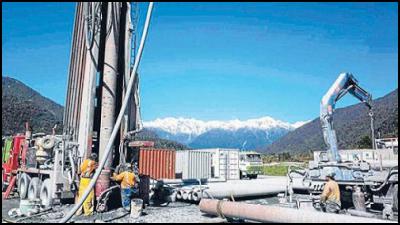Alpine Fault is hot, hot, hot
Drilling into the Alpine Fault to measure the conditions of the fault and monitor what happens before a major earthquake, a team of New Zealand and international scientists found extremely hot water just a couple of hundred metres down.

The Westland Deep Fault Drilling Project — jointly led by Victoria University of Wellington, GNS Science and the University of Otago — drilled almost 900m into the fault from a site in Whataroa near Franz Joseph. The team published a paper in Nature about their surprising find of water hot enough to boil only 630m down, with temperatures at the bottom of the borehole (around 820m) around 120C.
The San Andreas fault in California was drilled in a similar way, Professor Dave Craw from the University of Otago who was not involved in the study, told the Associated Press. But the “temperatures and thermal gradient encountered there were much lower than the Alpine Fault”, making the high temperatures unusual in a global context.
“We’d always thought it was going to be warmer than normal,” Professor John Townend told Radio NZ, because the Southern Alps are being lifted up rapidly (in geological timescales) by tectonic processes bringing up rocks from a great depth. “That process brings heat up from the portions of the crust and concentrates it in the shallow subsurface. Then the rainwater that falls on the West Coast seeps into the hot rocks and mines all that heat.”
But as lead author Professor Rupert Sutherland from Victoria University of Wellington explained on Newsroom, this discovery was “much, much hotter than people predicted, probably about five times hotter than normal crust, and about twice as hot as all bore holes that have ever been drilled.” These kinds of temperatures are extremely rare and usually only found in volcanic regions – like the Taupo Volcanic zone — where magma is close to the surface; but Westland is not volcanic at all.
The geothermal find has spurred speculation about power generation, but because of the location, the researchers think it might be more applicable to the dairy and tourism sector. Prof Sutherland said that low-grade heat could be used for tourist hot springs as well as industrial or agricultural uses like milk processing.
Read a summary of media coverage on the study.




 Coalition to End Big Dairy: Activists Protest NZ National Dairy Industry Awards Again
Coalition to End Big Dairy: Activists Protest NZ National Dairy Industry Awards Again Infoblox: Dancing With Scammers - The Telegram Tango Investigation
Infoblox: Dancing With Scammers - The Telegram Tango Investigation Consumer NZ: This Mother’s Day, Give The Gift Of Scam Protection And Digital Confidence
Consumer NZ: This Mother’s Day, Give The Gift Of Scam Protection And Digital Confidence NZ Airports Association: Airlines And Airports Back Visa Simplification
NZ Airports Association: Airlines And Airports Back Visa Simplification Netsafe: Statement From Netsafe About Proposed Social Media Ban
Netsafe: Statement From Netsafe About Proposed Social Media Ban The Reserve Bank of New Zealand: 2024 General Insurance Stress Test Results Published Today
The Reserve Bank of New Zealand: 2024 General Insurance Stress Test Results Published Today 